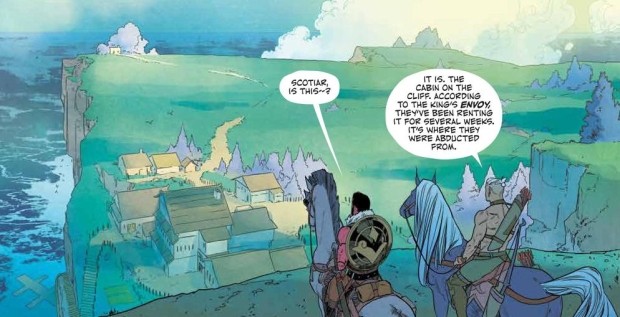by Natasha Alterici and Rachel Deering (letters)
collects Heathen #5-8
volume reviews: one | two | three [complete]
The queer viking fantasy Heathen quickly ascended its humble Kickstarter beginnings to become a huge hit. The debut book, both written and drawn by Natasha Alterici, was not only picked up by publisher Vault Comics, but we might see Aydis and her viking world portrayed on the big screen, as Alterici also snagged a movie deal.
Thankfully, regardless of its newfound fame and adoration, the second volume of Heathen expands on the enchanting and dark Norse fantasy world, building on the best of what the first installment had to offer. Aydis’ quest to subdue Odin’s grip on the mortal world (read: the patriarchy) takes her seaward, with a most excellent and queer captain and pirate crew, but her actions have caught the attention of the All-Father, who intends on stopping this new threat. We also continue to follow immortals Brynhild and Freyja whose own efforts to resist are met with varying degrees of success.

Alterici takes a a step back from clearly laying out the metaphors in the book (a weakness of the first volume), leaning more into the mythology fantasy and storytelling; the metaphors are still there, but it’s a more engrossing and authentic read. She has a very strong voice for talking animals and mythical creatures, remaining a strong point of the story as we both revisit some and meet new – it gives the fantasy world an amusing yet dangerous and unpredictable tone that’s very intriguing. (I name dropped Gaiman as a comparison last time and it still holds.) I was hoping we’d run into the two dogs again, hopefully they’ll make an appearance in the next volume.
Fans of queer comics and literature will love the diverse, all female/nonbinary pirate crew who liberate slaves from other pirates. Is it a bit unrealistic that Aydis would *immediately* stumble upon this kind of crew? Yes, but WHO CARES IT’S GLORIOUS. Most importantly, Aydis grows as a character away from her immortal companions (whose bigger personalities overshadowed her own) and makes high-stakes errors necessary for a true protagonist, especially in a fantasy story. I wasn’t sure if Aydis could carry the story on her own, but in this volume, she reclaims the role of protagonist in Heathen.

The weakest aspect for me was Freyja and Odin’s meta conversation about Why The World Is The Way It Is. It’s where Alterici puts her patriarchy metaphor, which, while more effective than last volume, still made the story drag. I also had trouble following a few minor plot points, such as a character death and the captain finding out something important about Aydis, but this could be due to a significant amount of time between reading volumes.
Alterici’s art skills have grown tremendously since the last volume – which was already an impressive feat – and it’s already a huge accomplishment to both write and illustrate a comic book. Visual standouts during the volume include really beautiful scenes on the pirate ship as well as underwater, and lovely sepia tone lighting in a scene between Freyja and Brynhild.
And just like last time, most of the women are sparsely dressed because of their strength and respective cultures – Aydis actually explains her lack of armor in a scene – to subvert the patriarchy in their world, as well as the male gaze in our own. Alterici does a beautiful job showing a lot of skin in a way that feels both natural and empowering for her female protagonists.

When I reviewed the first volume, I said the colors were too muted for the story, but my opinion has changed on this. The color palette still leans heavily on neutrals, but I’ve come to realize that it fits the Norse mythology world and is a nice match for the story. Moreover, Alterici’s use of dramatic shadows and highlights, as well as her overall improvement in this volume, helps offset the lack of color. But I still stand by this prediction: we’ll see more color if Aydis successfully unseats Odin.
According to Hollywood Reporter, Ashley A Woods will be joining as Heathen’s artist beginning with the next arc. Alterici was dealing with hand pain, which was the cause of Heathen’s hiatus last year, so this will help Alterici focus on the very important task of healing her hand, while still directing the writing and overall story. It will be interesting to see how the shift to a two person team might impact the series. Regardless, I highly recommend the series and impatiently waiting for volume three.














